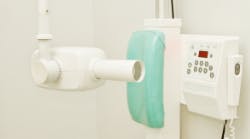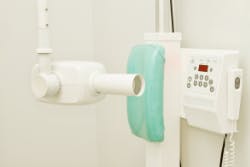Radiation safety in the dental office should not be overlooked
By Bart Leclou
Dental professionals in 2018 have access to state-of-the-art equipment that makes diagnosis and treatment of oral disease much easier than it was even 10 years ago. The emergence of digital imaging has revolutionized dentistry with the ability to obtain clear X-rays to help formulate a plan of treatment. The advances have come at a cost—increased exposure to ionizing radiation for both patients and staff.
The United Nations Scientific Committee on Effects of Atomic Radiation reported in 2008 that approximately 480 million diagnostic radiographic examinations in dentistry are performed worldwide every year, comprising 15% of all diagnostic X-rays in health care. Those numbers have only continued to increase. While radiation doses are low for individual examinations, the cumulative effect for patients and staff can reach dangerous levels. It is not wise to ignore the importance of monitoring the use of ionizing radiation.
Monitor radiation exposure
Dosimeters can help give dentists and staff peace of mind. The Instadose+ dosimetry system, for example, allows radiation safety officers monitor radiation dosing in their offices. Instadose+ badges allow dental offices to capture dose information instantly by downloading results onto a computer or mobile device, eliminating the need for badge collection and redistribution. Instadose+ badges are processed by organizations certified by the National Voluntary Laboratory accreditation program, so the results can be used as dose of record for compliance with state and federal regulations.
Employees are vital to the success of any dental practice, so it’s very important to keep them safe. Asking employees to wear an dosimetry badge sends a clear message: Individual health is a top priority, and tracking exposure closely and making appropriate changes where necessary will go a long way to make sure employees will not experience any long-lasting effects of ionizing radiation.
The benefit extends beyond employees, however. Any health-care office that prioritizes the needs of its staff is also sure to keep patients safe, as well. Patients may ask about the cumulative effects of radiation, and they will see every precaution is taken to limit exposure to both patients and staff.
American Dental Association statement
The revised ADA/US Foood and Drug Administration recomendations issued in 2012 state:
Although dental professionals receive less exposure to ionizing radiation than do other occupationally exposed health care workers, operator protection measures are essential to minimize exposure. Operator protection measures include education, the implementation of a radiation protection program, occupational radiation exposure limits, recommendations for personal dosimeters and the use of barrier shielding.The maximum permissible annual dose of ionizing radiation for health care workers is 50 millisieverts (mSv) and the maximum permissible lifetime dose is 10 mSv multiplied by a person’s age in years.Personal dosimeters should be used by workers who may receive an annual dose greater than 1 mSv to monitor their exposure levels. Pregnant dental personnel operating x-ray equipment should use personal dosimeters, regardless of anticipated exposure levels.
Image Gently with children
Limiting exposure to ionizing radiation is especially important when working with children. Children have an approximately three to five times higher radiation-induced cancer mortality risk than adults, according to the Image Gently Alliance. Image Gently is a coalition of health-care organizations—including dental offices—dedicated to providing safe, high-quality pediatric imaging nationwide. The Alliance encourages dental professionals to:
- Always use thyroid collars.
- “Child-size” exposure to ionizing radiation.
- Use the fastest image receptor possible.
- Use X-rays when a child individually needs them, and not as a matter of routine.
- Only use cone-beam computed tomography (which emits a higher level of radiation) when absolutely necessary.
The Image Gently in Dentistry Campaign, which is a subset of the Alliance, urges dentists to use X-rays and other imaging in accordance with the ALADA, or As Low As Diagnostically Acceptable, principle. In other words, while imaging does serve a valuable function in diagnosing oral disease, it should only be used when needed.
Eliminate accidental exposures
Low doses of dental ionizing radiation have shown to be more useful than harmful when applied correctly—and, of course, dental X-rays do emit very low doses. However, there can be extenuating circumstances in any individual situation.
One way this can occur is with a malfunctioning machine. That is why it is important to have a physicist check imaging equipment every one or two years to ensure it is performing at a high level. If a staff member becomes exposed to faulty equipment, the cumulative effect could be dangerous.
Another possible situation is accidental exposure—such as when a staff member is unknowingly exposed to a higher dose of ionizing radiation. These are situations in which dosimetry systems are especially helpful. When an employee is wearing an dosimeter badge, it’s possible to get on-demand readings to determine whether he or she has received a higher than expected dose.
There are many aspects to running a dental office, and radiation safety is just one line item in a long list. But it is an important line item — one that is easily resolved by following the above suggestions. It’s important to keep staff and patients safe, and maintain an office that is exemplary in its compliance with safety regulations.








